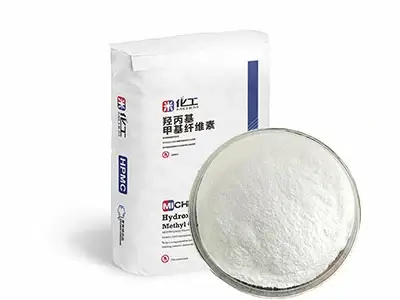What is HPMC?
HPMC, which stands for Hydroxypropyl Methylcellulose, is a chemical compound derived from natural cellulose sources such as wood or cotton fibers. It is produced through a chemical process that involves modifying cellulose with propylene oxide and methyl chloride.

The resulting HPMC compound possesses enhanced solubility, stability, and thickening properties compared to natural cellulose.
General Properties of HPMC
HPMC (Hydroxypropyl Methylcellulose) possesses several general properties that contribute to its wide range of applications. These properties include Water Solubility, Thickening Agent, Surface Activity, Film-Forming Ability, pH Stability,and Non-Ionic Nature.
- Water Solubility: HPMC exhibits excellent solubility in water, allowing it to form clear and homogeneous solutions. This property makes it easy to incorporate into various formulations.
- Thickening Agent: HPMC acts as an effective thickener, providing viscosity control in solutions. It can increase the viscosity of liquids, enhancing texture and stability in various formulations.
- Surface Activity: HPMC reduces surface tension, which improves wetting and spreading properties. This property is beneficial in applications where better adhesion and coating coverage are desired.
- Film-Forming Ability: When HPMC solutions or dispersions dry, they can form flexible and transparent films. This property is valuable in coating applications, where a protective or decorative film is desired.
- pH Stability: HPMC maintains its performance in a wide range of pH conditions, from acidic to alkaline. It remains stable and retains its functional properties across a broad pH spectrum.
- Non-Ionic Nature: HPMC is classified as a non-ionic compound, meaning it is electrically neutral. This characteristic allows it to be compatible with a wide range of other substances, making it versatile in formulations and allowing for synergistic effects with other ingredients.
Construction grade HPMC
Construction-grade HPMC (Hydroxypropyl Methylcellulose) refers to a specific type of HPMC that is specifically formulated and optimized for use in the construction industry. It offers a range of properties and benefits that make it suitable for various construction applications. Here are some key features of construction-grade HPMC:
- Water Retention: Construction-grade HPMC is an excellent water-retaining agent. When added to cement-based mixtures, it improves their water-retaining capacity. This property is particularly valuable in construction applications as it helps to prevent premature drying and shrinkage, enhancing workability and reducing the risk of cracking.
- Improved Adhesion: HPMC enhances the adhesion of cement-based materials to various substrates, such as concrete, masonry, or tiles. It improves the bond strength and durability of the construction elements, ensuring long-lasting performance and reducing the risk of delamination or detachment.
- Workability Enhancement: HPMC enhances the workability and cohesiveness of cementitious materials, such as mortars and renders. It imparts a creamy texture and improves the ease of handling, making the mixtures more pliable and easy to apply. This workability enhancement allows for better construction efficiency and improved application properties.
- Compatibility: Construction-grade HPMC is compatible with a wide range of other additives commonly used in the construction industry. It can be easily incorporated into cementitious formulations without negatively affecting the performance or stability of the final product.
Typical Applications of Construction grade HPMC
Tile Adhesives: HPMC is an essential component in tile adhesives. It enhances the adhesive properties, allowing for better bonding between tiles and the substrate. The water-retaining capability of construction-grade HPMC helps to prevent the premature drying of the adhesive, ensuring proper hydration and curing.


Gypsum-Based Products: HPMC is also used in gypsum-based products, such as gypsum plasters and joint compounds. It improves the workability, water retention, and adhesion properties of the gypsum formulations.
Exterior Insulation and Finish Systems (EIFS): HPMC is used in EIFS as a binder and thickening agent. It improves the workability of the system, enhances adhesion to the substrate, and provides weather resistance.


Cementitious Grouts: Construction-grade HPMC is employed in cementitious grouts used for filling joints between tiles or stones. It improves the workability and ensures proper flow into the joints. The water-retaining properties of HPMC help to prevent excessive water loss, ensuring complete hydration and reducing the risk of cracking.
Mortars and Renders: Construction-grade HPMC is extensively used in mortars and renders. It acts as a water-retaining agent, improving the workability and reducing the risk of premature drying. It enhances the adhesion and bond strength of the mortar or render to the substrate, ensuring a durable and long-lasting finish.


Self-Leveling Compounds: HPMC is used in self-leveling compounds to improve their flow and leveling properties. It enhances the workability and provides thixotropic behavior, allowing for smooth and even application. The water-retaining capacity of HPMC helps to control the curing process and prevent shrinkage.
HPMC suppliers
There are several suppliers and manufacturers of HPMC (Hydroxypropyl Methylcellulose) worldwide. Here are some well-known HPMC suppliers:
- Dow Chemical Company: Dow offers a range of HPMC products under the brand name METHOCEL™. They provide HPMC for various industries, including construction, pharmaceuticals, food, and personal care.
- Shin-Etsu Chemical Co., Ltd.: Shin-Etsu is a global supplier of chemicals and materials, including HPMC. Their HPMC products are used in various applications, such as construction, pharmaceuticals, and cosmetics.
- Ashland Global Holdings Inc.: Ashland offers HPMC products under the brand name Natrosol™. Their HPMC grades are used in construction, coatings, personal care, and other industries.
- Lotte Fine Chemical: Lotte Fine Chemical is a leading supplier of HPMC. They provide HPMC under the brand name Mecellose™, catering to industries such as construction, coatings, pharmaceuticals, and food.
- Shandong Michem Chemical Co.,Ltd.: Shandong Michem Chemical Co.,Ltd is a prominent HPMC manufacturer based in China. They supply HPMC products for multiple applications, including construction, paints and coatings, and personal care.
Why Michem HPMC
Michem HPMC stands out in the market for several reasons:
- Quality assurance: Michem is known for its commitment to quality control and assurance. Michem HPMC undergoes rigorous testing and quality checks at every stage of production to ensure consistent and reliable performance.
- Technical expertise: Michem has a team of experienced professionals and technical experts who provide comprehensive technical support and guidance to customers. They offer valuable insights and recommendations on product selection, formulation, and application techniques.
- Research and development: Michem invests in ongoing research and development activities to continually improve its HPMC products and develop innovative solutions. This ensures that customers benefit from the latest advancements in HPMC technology.
- Customization: Michem offers a wide range of HPMC grades with varying viscosity, and substitution levels, allowing customers to choose the most suitable product for their specific application requirements.
- Customer satisfaction: Michem values customer satisfaction and strives to build long-term partnerships with its clients. The company focuses on understanding customer needs and providing tailored solutions .
Choosing Michem HPMC ensures reliable and high-quality performance for a wide range of applications. Contact us today!

